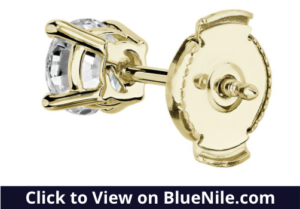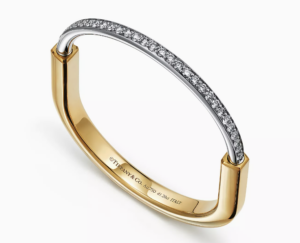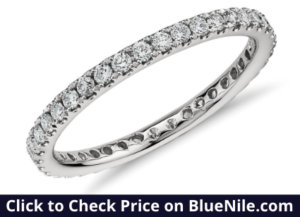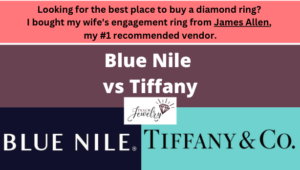
Blue Nile and Tiffany & Co. are two of the most prominent brands in jewelry, though they offer unique buying experiences and products.
Based on their wide selection of jewelry, quality prices, and exceptional buying experience, I recommend Blue Nile.
But let’s compare Blue Nile versus Tiffany across the areas most important to buying jewelry, such as their selection, quality, price, return policies, and more.
Overview of Blue Nile
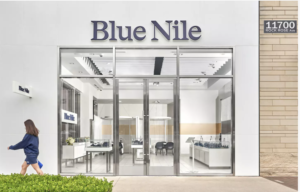
Blue Nile is an online jewelry retailer known for its wide selection of engagement and wedding rings, necklaces, bracelets, and more. They’ve recently opened physical retail stores.
It was founded in 1999 and is based in Seattle, Washington.
Shoppers used to rely on a personalized, in-store experience when purchasing such expensive pieces of jewelry.
Blue Nile pioneered the online buying experience in an industry formerly dependent on brick and mortar retail.
Due to its success, other online diamond vendors such as James Allen (where I bought my wife’s engagement ring) have entered the market.
Blue Nile prides itself on working directly with manufacturers and wholesalers to offer customers a low price. With minimal overhead and fewer parties involved in the transaction, they avoid the high markups of other retailers.
The company also promotes its diamonds as conflict-free and follows the Kimberley Process of identifying and sourcing diamonds.
You can read the full history of the company on their website here, or check out my extensive Blue Nile review.
Overview of Tiffany’s

Tiffany & Co, known as Tiffany’s, is a luxury jeweler headquartered in New York City.
It’s primarily known for its engagement rings and the Tiffany setting, which is a six-prong solitaire setting designed to maximize the prominence of the center diamond.
Other retailers offer a similar design, but Tiffany patented its version of this setting.
It also sells other jewelry such as:
- Necklaces and pendants
- Bracelets
- Earrings
- Sterling silver
- Watches
Tiffany’s was founded in 1837 by Charles Lewis Tiffany and today has more than 300 stores around the world.
It began offering its products online as the idea of selling jewelry through a website became more commonplace.
It’s still known for its in-store experience, but you can also find a wide selection online and have it shipped to you.
Like Blue Nile, Tiffany’s only sells conflict-free diamonds and abides by the Kimberley Process.
What are the Differences Between Blue Nile and Tiffany?
1. Selection of Diamonds and Jewelry
Blue Nile has a much wider selection of diamonds than Tiffany’s.
In fact, Tiffany’s doesn’t sell loose diamonds. They’re only available as part of rings.
Blue Nile has more than 350,000 round-cut diamonds across all carats, colors, cuts, and clarity grades. You can view the full selection on their “Diamond Finder” page.
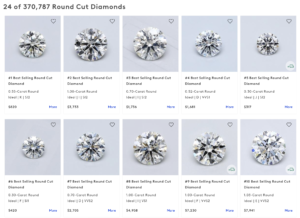
It sells more than 34,000 emerald cuts, 13,000 pear cuts, and 3,000 radiant cuts.
Tiffany’s selection in the engagement ring category also pales compared to Blue Nile.
In the “Engagement Rings” section of their website, there are only 53 options.
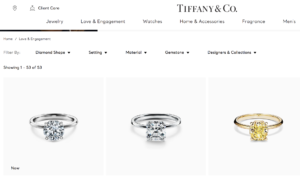
Variations include:
- Platinum, 18k, and rose gold settings
- Cushion cut diamonds surrounded by a halo
- Settings with pave diamonds down the shank
- Three-stone engagement rings with pear-cut diamonds on the sides
Tiffany’s allows you to customize an engagement ring by pairing a diamond with more than 20 types of settings in platinum or rose or yellow gold.
But Blue Nile’s customization options allow you to do the same with all its loose diamonds and any type of shank.
For example, I often point readers toward their line of halo settings, like this platinum design.
The same idea is true for wedding rings. On its website, Tiffany’s lists 129 variations in gold, sterling silver, titanium, and more.
Some feature diamonds or rubies, and others are knife edge rings.
Blue Nile’s selection of wedding rings includes more than 1,000 variations across cobalt, titanium, tungsten, and more. There are 14 distinct styles such as channel-set, eternity, and vintage.
One of my favorite lines is their micro pave, half-eternity rings, like this one.
Whether you want your wedding ring to shine like your engagement ring, or want a simple band without sparkle, you can explore every type at Blue Nile.
So if you’re looking for which diamond store has the most choices, we recommend Blue Nile over Tiffany’s.
2. Quality
Don’t judge the quality of a diamond based on the vendor, whether it’s Blue Nile, Tiffany’s, James Allen, or Zales.
Instead, it should be evaluated by a reliable third-party organization such as the Gemological Institute of America (GIA) or American Gem Society (AGS), so you can be confident in its traits.
All Blue Nile diamonds are assessed by the GIA, and it often includes a copy of the report on the website. This is a feature that makes Blue Nile one of my recommended vendors.
Select a loose diamond, scroll down, and click “View Report” under the GIA logo.
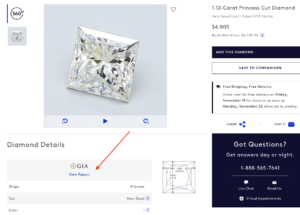
It will show its clarity, cut, carat, and color, in addition to other important measurements such as:
- Symmetry and polish
- Proportions
- Types of inclusions
The GIA applies its rigorous standards to each of these areas. If the report rates it highly across many of those characteristics, you can have confidence in its quality.
Tiffany’s diamonds don’t come with GIA reports. Instead, Tiffany’s has its own grading lab. Grading diamonds in-house is viewed by some as a conflict of interest.
A company has incentive to grade diamonds higher than a third-party institution would, so the diamond will sell at a higher price.
That being said, Tiffany’s is known to use high standards. It may not live up to the standards of the GIA or AGS, but it often exceeds those of less reputable organizations.
For example, they only sell diamonds in the “near colorless” or “colorless” ranges. This often means any yellow tints aren’t visible to the naked eye.
The same idea is true for clarity. Tiffany’s says they won’t sell diamonds that have inclusions visible to the naked eye. This is known as an eye-clean diamond.
Whether you’re buying a diamond from Tiffany’s or Blue Nile, don’t determine its quality based on the brand.
Examine the grading report to learn its traits, and if available, view a high-resolution image of the actual gem.
In terms of jewelry, you’ll find exceptional quality from both brands. As examples, check out this pair of diamond stud earrings from Blue Nile.
You can select the type of metal, such as 14k yellow gold, and its total carat weight.
If you’re searching for bracelets, they have a stunning tennis bracelets available in yellow, white, and rose gold. They’re plated with rhodium for prevent tarnishing and improve its longevity.
Tiffany’s fine jewelry is also known for its quality offerings.
Take this bangle in yellow and white gold.
It’s a unique piece with 1.20 carats of pavé diamonds.
There’s a range of designs to fit nearly every style across bracelets, rings, charms, and more.
3. Pricing
Tiffany’s diamonds are more expensive than ones from Blue Nile. If you compare diamonds from each retailer, Tiffany’s diamonds often cost twice as much.
For example, let’s compare the prices of Blue Nile and Tiffany’s engagement rings with a solitaire setting and a diamond with the following traits:
- Carat weight: 1.01
- Color: H
- Cut: Excellent
- Clarity: VVS1
At Tiffany’s, this engagement ring sells for $14,600.
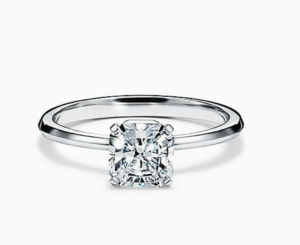
At Blue Nile, this engagement ring sells for $6,090.
As another example, this engagement ring from Tiffany’s includes pave diamonds on the shank. It sells for $21,000.
This ring from Blue Nile also has a platinum band with pave and the same quality diamond on top. Its price is $6,800.
When comparing the prices of Blue Nile versus Tiffany’s diamond rings, you can save a significant percentage by ordering the same quality ring from Blue Nile.
The same is true for wedding rings.
As a comparison, here’s an eternity wedding band in platinum from Blue Nile with 0.5 carats of diamonds.
It costs $1,690.
Tiffany’s sells this full eternity ring with a lower total carat weight, 0.34, but it’s priced at $3,750. That’s a 121 percent premium for a similar style.
No matter what type of jewelry you choose, you’ll likely pay more at Tiffany’s compared to Blue Nile.
4. Online Buying Experience
Blue Nile’s seamless online buying experience is part of the reason the company become an industry leader.
I’ll start with my favorite feature on Blue Nile’s site, called “Build Your Own Ring.”
In the main navigation, under “Engagement Rings,” choose to start with a diamond or setting. In this example, I’ll start with a diamond.
Beginning with hundreds of thousands of choices, you can apply filters to meet your criteria. Let’s say I want an eye-clean emerald cut that weighs one carat and appears colorless.
By selecting the filters below, Blue Nile’s site returns 71 options.

When I click “Add to Ring” with my chosen diamond, I’m taken to their settings.
I can apply more filters related to price, shape, metal, and material.
Once I’ve chosen the setting, Blue Nile creates an image of the complete diamond ring.
It’s a simple process from start to finish, which makes Blue Nile’s online buying experience first-class.
Tiffany’s does provide customization options, but they aren’t as extensive as Blue Nile.
Additionally, I went through the process of choosing an engagement ring with a Tiffany setting. After I selected the diamond and setting, I had to call the company to purchase it instead of placing it in my cart for immediate checkout.
This isn’t an inherently poor experience, but it doesn’t rival the convenience offered by Blue Nile.
Tiffany’s online process for most other jewelry is easier. I selected a women’s wedding ring and its size, and the site took me right to checkout.
As a general rule, Blue Nile’s online experience is exceptional regardless of the item.
At Tiffany’s, I recommend visiting the store for a significant purchase like an engagement ring. You’ll also get to experience their exceptional in-store service.
5. Branding and Image
Tiffany’s knows jewelry shoppers aren’t only buying a ring. They’re often buying a status symbol and want a strong image associated with their jewelry.
That’s why Tiffany’s has spent decades, and millions of dollars, creating a sought-after brand that stands for quality. It’s why their pieces come in that iconic blue box.

They want to convince you that you aren’t only buying jewelry. You’re buying luxury.
So their jewelry commands a premium price compared to many other online and in-person retailers.
Blue Nile, on the other hand, brands itself as offering a smooth online shopping experience and low prices.
By working directly with wholesalers and manufacturers, they’re less concerned with building a luxury jewelry brand and more concerned about presenting an image of affordable, quality diamonds.
As a result, their margins aren’t as high.
If you’re focused on value, choose Blue Nile over Tiffany’s.
But if you want a premium brand that adds a sense of luxury to your purchase, Tiffany’s offers this experience.
Neither of these brand associations is right or wrong. It’s about deciding which is more important for you.
6. Customer Service
When you’re buying an expensive item like an engagement ring, you expect excellent customer service from the beginning to the end of the buying experience.
Both Tiffany’s and Blue Nile promote their quality customer service, but each offers it in a different way.
To categorize them broadly, Tiffany’s wants to offer a personalized buying experience, while Blue Nile’s business model is more about allowing the customer to handle the transaction themselves.
What we mean by that is Tiffany’s in-store experts can walk you through buying a piece of jewelry, explaining its qualities such as cut and clarity, and allowing you to view the piece in person.
Blue Nile and many of their online alternatives allow you to create your engagement ring online, and they’ll ship it to you.
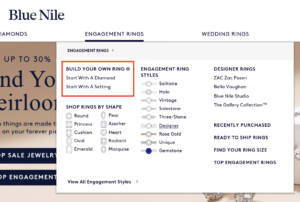
You don’t have to interact with anyone on their team throughout the process, though they’re available by chat, email, or phone to assist you.
Recently, they’ve expanded their footprint beyond their online store and built physical retail stores, but the vast majority of their business is still done online.
Tiffany’s customer service department offers many of the same features as Blue Nile’s, but they pride themselves on that one-on-one experience.
If you’re looking for an efficient buying experience that still offers comprehensive customer service when you need it, Blue Nile fits the bill.
If you want a personalized experience in selecting the perfect diamond ring, Tiffany’s could be the right fit, but you’ll pay a premium.
7. Returns and Warranty
Tiffany’s and Blue Nile both offer returns and warranties, but it’s important to know the details of those policies.
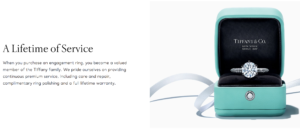
Tiffany’s offers refunds for items returned within 30 days, and they’ll pay for the shipping.
They don’t provide refunds for engraved items, so if the setting has a few words engraved inside, you won’t get your money back for it.
You can read Tiffany’s complete return policy here.
Blue Nile also requires you return the item within 30 days, and they’ll send a shipping label. Similar to Tiffany’s, they don’t offer returns on engraved items.
You can read Blue Nile’s complete return policy here.
Both companies provide warranties, and there’s not much difference in coverage between Blue Nile and Tiffany’s.
Tiffany’s offers free cleaning and polishing for the life of the ring. For repairs, you can send in your ring, and they’ll provide a free estimate.
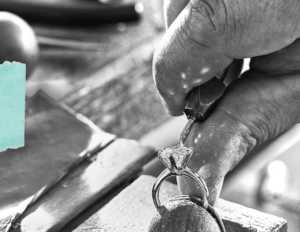
It also comes with a ring upgrade program, where you receive a credit for your original purchase when buying the new one.
Blue Nile offers a lifetime warranty with an upgrade program and free cleaning.
If your piece has a defect from manufacturing, it can be returned for an inspection. From there, they’ll either replace or repair it.
This warranty doesn’t include the slight irregularities or variations that result from the craftsmanship or natural characteristics such as inclusions.
The company says it’s part of the natural characteristics of the diamond and isn’t considered a defect under its policies.
8. Shipping
Because so much of the jewelry industry has moved online, you’ll want to know the shipping policies of both companies.
Tiffany’s and Blue Nile offer free shipping on all orders.
At Tiffany’s, this means standard group shipping, which is typically three to five business days, for orders under $1,000.
If it’s priced over that mark, it qualifies for free express shipping.
If you’ve waited until the last minute, Tiffany’s has you covered.
There’s complimentary next-day delivery on orders above $5,000.
On the other hand, Tiffany’s only ships to addresses in the United States.
It’s worth noting they request an additional one to two days for engraved items and three to four days for monogrammed or hand-engraved pieces.
Blue Nile’s shipping policies are similar:
- Free ground shipping for orders under $500
- Free two-day shipping for items between $500 and $1,500
- Free overnight for $1,500 and above.

For overnight with Saturday delivery, it depends on available, and there will be an additional charge.
And unlike Tiffany’s, Blue Nile ships to 40 countries.
9. Customer Reviews
It’s not enough to read what companies promote about themselves on their website. Where you learn whether they live up to those promises is to read what customers have said and wrote about them.
Blue Nile boasts an A+ rating from the Better Business Bureau (BBB).
That doesn’t mean they’ve never received a bad review from customers, but it does mean they take complaints seriously and connect with customers to resolve them.
Tiffany’s has also earned an A+ from the BBB, so if you have an issue, you can be confident the company will at least try to resolve it.
Other online review platforms are less kind to Tiffany’s.
For example, they have 2.1 out of five stars on their TrustPilot.com profile from 260 reviews.
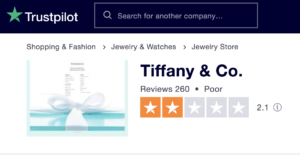
Common themes include customer service teams that are slow to respond and feeling the quality of the jewelry doesn’t live up to its price.
On the other hand, customer reviews on Tiffany’s Consumer Affairs page are more positive at four out of five stars from 175 ratings.
The overall online sentiment toward Blue Nile is more positive versus Tiffany’s.
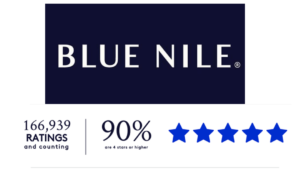
For example, one reviewer on Reddit documents their experience of buying the wrong diamond.
They sent it back, were provided the refund, and the customer service representatives were knowledgeable about the process.
Another reviewer wrote how it’s the right place to buy an engagement ring if you’re familiar with the four Cs of color, clarity, cut, and carat.
If so, you might not need a jewelry expert to walk you through the process, so Blue Nile makes it easy.
Should you Buy Jewelry from Blue Nile or Tiffany’s?
Blue Nile and Tiffany’s are two of the largest diamond and jewelry retailers and boast many satisfied customers.
I’m confident you’ll be satisfied with both vendors.
But if you’re deciding between Blue Nile versus Tiffany’s, I recommend Blue Nile because of their quality inventory, low prices, and smooth buying experience. They’re one of the best online diamond stores.
For further guidance, here are some tips to help you decide.
Opt for Blue Nile if:
- You’re most interested in affordability and aren’t concerned whether your jewelry is associated with a luxury brand
- You want to maximize the number of options for your engagement ring by pairing various cuts and settings
- The online experience is appealing, and you want to complete the process without setting foot in a store
Tiffany’s might be the right choice for you if:
- You’re set on the classic Tiffany setting engagement ring
- You acknowledge you’ll often pay a higher price for the same quality diamond you could find elsewhere, but the Tiffany brand is appealing to you
Explore both brands and their wide selection of jewelry, so you can learn whether Blue Nile or Tiffany’s has the right piece for you.

Jacob Clarke
Jacob Clarke is the founder of TeachJewelry.com.
He earned an Applied Jewelry Professional Diploma from the Gemological Institute of America (GIA) and now brings you essential information about diamonds, settings, and more.
Jacob has consulted with leading jewelry brands, and his work has been cited in Clean Origin, Diamond Nexus and industry publications.
He's also a member of the International Gem Society.
He enjoys discussing jewelry with readers, so contact him with any questions at jacob.clarke@teachjewelry.com.

